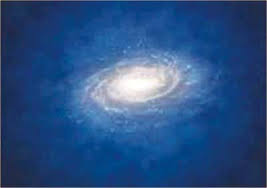SCIENTISTS using Earth based experiments to detect
particles of dark matter might now know why they keep coming up empty-handed:
There may be no dark matter in the solar neighborhood at least, not within
13,000 light-years, reports a study appearing in an upcoming issue of the
Astrophysical journal.
 Though dark matter, a mysterious
substance different from ordinary, visible matter, supposedly makes up more than
80 percent of the matter in the universe, the new work suggests that the solar
system lives in a dark matter desert. That's a problem, because most scientists
think that the Milky Way galaxy is embedded in a large halo of dark matter.
Though dark matter, a mysterious
substance different from ordinary, visible matter, supposedly makes up more than
80 percent of the matter in the universe, the new work suggests that the solar
system lives in a dark matter desert. That's a problem, because most scientists
think that the Milky Way galaxy is embedded in a large halo of dark matter.
If the results hold, scientists will have
to reconsider what sort of shape that dark matter halo takes, although it's sunlikely
to cause any major cosmological upheavals.
"This doesn't mean that dark matter
does not exist," says study coauthor Christian Moni Bidin, an astronomer
at the Universidad de Conception in Chile. "The result is only that dark
matter in not where we expected it."
Dark matter explains many things, including
the rotation speed of the Milky Way. Its outer reaches spin more rapidly than expected
based on the amount of mass sequestered in visible stars. Scientists have deduced
that unseen matter, probably in the form of exotic subatomic particles, engulfs
the speeding galaxy, exerting a gravitational force that accounts for the rapid
rotation.
Since dark matter is invisible,
scientists can't directly observe it in space. Instead, they infer its presence
by looking for its gravitational effect on things like stars, gas, and light
from distant galaxies. For the new work. a team in Chile went hunting for changes
in the paths of stars crossing the sky, sinuous indicators that masses of the
dark stuff lay nearby.
More than a year ago, astronomers
studied the motion of roughly 400 red giant stars that that hovered far above
the galactic plane in the vicinity of the solar system, Now, the team in Chile
has calculated the amount of matter needed to explain the stars movements. That
total equals the mass of stuff they can see.
Ergo, no dark matter.
It's a challenging measurement, and one that
may not have been done right, says Chris Flynn, an astronomer at Swinburne
University of Technology in Melbourne, Australia. When Flynn applied the team's
method to a simulated galaxy with known quantities of dark matter and stars, it
failed to detect the simulated dark matter. "My best bet is that something
has gone astray in the measurements or analysis," says Flynn, a referee of
the paper. "I was able to show to my own satisfaction that there was a problem
of some kind in the method; but couldn't diagnose where the problem really is."
[Source : Science News]
No comments:
Post a Comment
safkatjamilimon@gmail.com